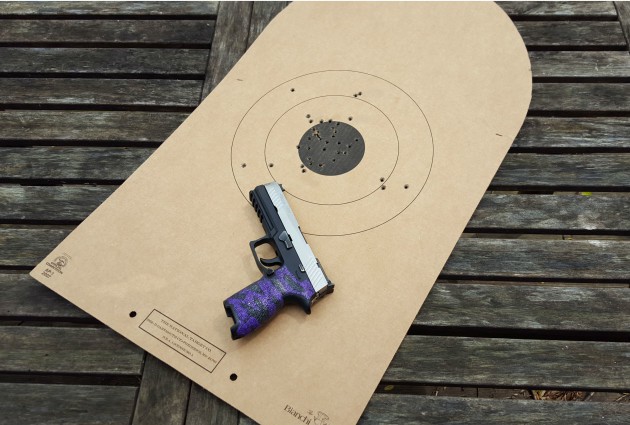Featured
Introduction to Competition Precision Shooting
Published
1 year agoon

Yesterday, we went on a whirlwind tour of action shooting sports. They’re a lot of fun, but they aren’t for everyone all the time. Fortunately, that doesn’t mean that competitive shooting isn’t an option because of what I’m going to broadly call “precision” shooting sports.

For our purposes here, precision sports are those that focus on making difficult shots. There may be a time element limiting how long you have to take the shot, but scoring is generally based on whether or not you hit the target and often, how well you hit the target – what part of the scoring zone on the target did you hit?
The classic precision shooting sports are Bullseye Pistol; its corresponding rifle sports: High Power, F-Class, Palma, and Smallbore; and their close relatives in the Olympic shooting sports. For all of these, the competitor shoots at what looks like the conventional bullseye most people think of when they think about target shooting, with concentric circles circling higher and higher point values as you get closer to the center.
The winner is usually the person who shoots the most points after firing a set number of rounds. In almost all of the pistol and rifle precision sports, the ideal shot lands inside the “X-ring”, a tiny circle inside a small circle assigned a value of ten points. Where an X-ring is used, it’s both worth ten points and an “X count” that breaks ties between multiple competitors who have shot the same total number of points.
Bullseye Pistol involves standing shooting rimfire and centerfire pistols one-handed at distances of 25 and 50 yards, at an X-ring in the center of the target as small as 1.7 inches across at 50 yards. Similarly, the various Olympic pistol sports use .22lr and air guns one-handed, but at distances ranging from 10 to 50 meters, at ten-rings that can be less than half an inch across. A closely related sport is NRA Action Pistol, which some people know as Bianchi Cup, the most well-known AP match. Under much tighter time pressure, competitors there shoot at paper targets and steel plates at distances out to 50 yards.
High Power, F-Class, Palma, Smallbore, and Olympic (air) rifle are all different kinds of rifle sports, differentiated by the exact type of rifle a competitor may shoot. Shot from distances ranging from 10 meters in the Olympic sports to 1000 yards in F-Class and Palma, the X-rings for all sports are challenging. For instance, High Power shooters aim at a 6-inch circle at 600 yards and Olympic shooters have 10rings as small as 0.5 mm – well under a quarter inch across!

F-Class and Palma are shot prone, lying down flat on the ground. High Power, Smallbore, and Olympic (air) rifle, however, require competitors to also shoot sitting or kneeling and prone. You might hear these sports called “Three Position”, which refers to each of the positions that are required in their matches.
Meanwhile, Benchrest allows shooters to fully support their rifles mechanically, but still requires the physical skills of perfect sight alignment and trigger press, as well as understanding of how wind affects a bullet’s flight at distances ranging from 100 to 1000 yards. There, a competitor might shoot for the smallest average group size, no matter where on the target, or for score like the more traditional sports above.
On the other end of the spectrum for pistols and rifles is Silhouette Shooting. A little bit like the Steel Challenge I mentioned in my last article, Silhouette has steel targets shaped like various animals that the competitor has a limited number of shots and limited time to knock over, using either a rifle or a pistol depending on the match.
And a modern descendent of all of the above is Precision Rifle, most famously as part of the Precision Rifle Series. There, modern rifles are used to shoot small steel targets at distances limited only by range facilities, often under artificially challenging conditions such as being required to use a car to support the gun.

And finally, last but not least, I don’t want you to think I’ve forgotten the traditional shotgun sports – Trap, Skeet, 5-Stand, and Sporting Clays – where a competitor must stand and shoot at moving “clay pigeons” before they disappear or fall to the ground. Even though shotguns shoot a full pattern of pellets, it can be difficult to make sure those pellets pass through the clay target to break or shatter it and count as a hit, especially when the clay is constantly and quickly moving both from the machine that throws the clay into the air and from the wind.
Wow! That’s a lot of competitive shooting out there, and I’ve really only touched on some of the major sports. I hope you’ll join me as I explore these and other areas of competitive shooting.
You may like

CZ 75 SP01 Tactical Gun Review | Gun Carrier

PODCAST: Gun Law Changes All Across America Right Now

PODCAST: How to Win Olympic Gold

PODCAST: 50 Important Ideas For Self-Defense, Self-Reliance, and Personal Safety

10 Best Gun Safes In 2022 | Gun Carrier

DP-12 | Double Barrel Pump Shotgun Gun Full Review


